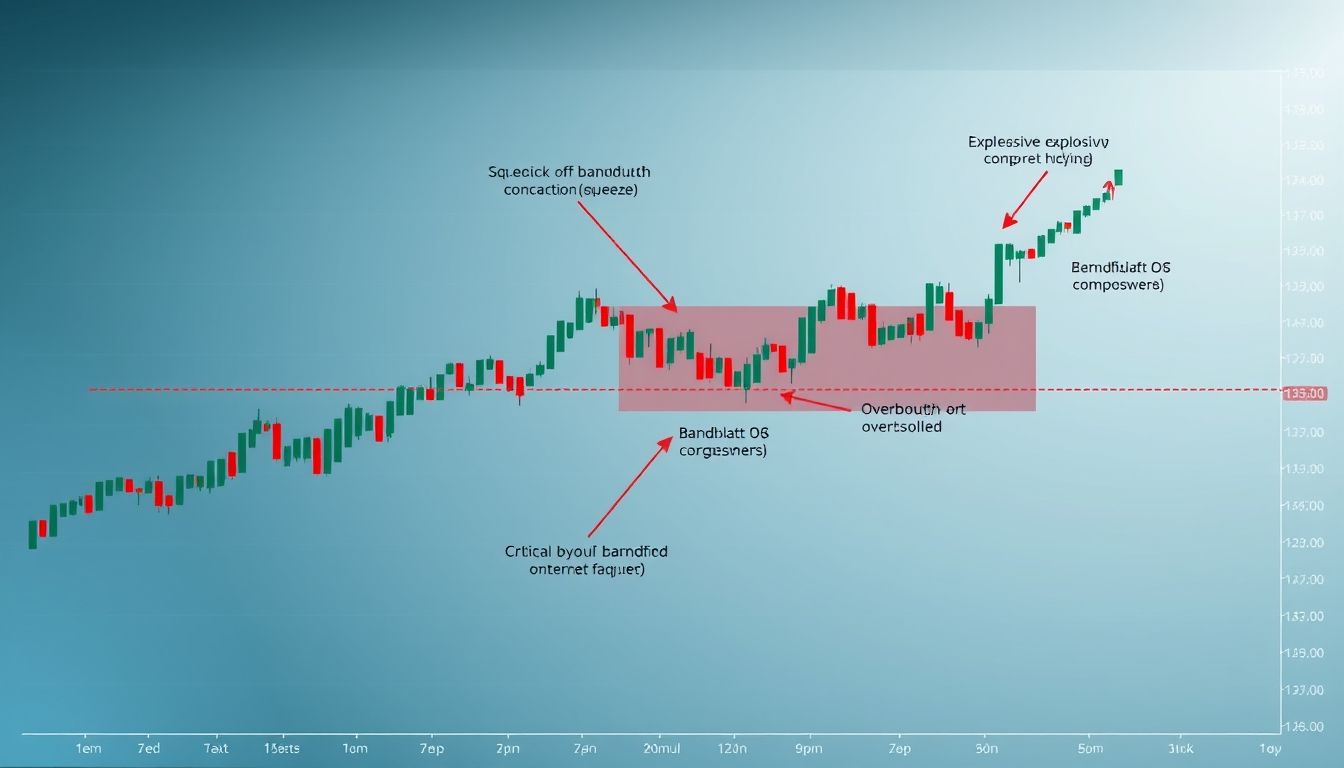Introduction to Bollinger Bands
Bollinger Bands are a popular technical analysis tool used to identify potential overbought and oversold levels in the market. Developed by John Bollinger in the 1980s, it relies on the concept of standard deviation to determine the range of price fluctuations around a simple moving average.
Components of Bollinger Bands
- Middle Band: Typically a 20-day simple moving average (SMA).
- Upper Band: Middle Band + (2 * 20-day standard deviation).
- Lower Band: Middle Band - (2 * 20-day standard deviation).
The 20-day period is the most common, but it can be adjusted according to the trading strategy and time frames used.
Chapter 1: Understanding the Basics of Bollinger Bands
To understand how to use Bollinger Bands effectively, it is essential to understand the basic principles on which they are based. The width of the bands reflects market volatility, with the bands widening in periods of high volatility and narrowing in periods of low volatility.
Interpreting Band Width
- Widening Bands: Indicate increasing volatility in the market, which may signal the start of a new trend or the end of an existing one.
- Narrowing Bands: Indicate decreasing volatility, which may signal a period of consolidation or the market preparing for a major move.
It is important to note that Bollinger Bands do not provide direct buy or sell signals, but rather help traders assess whether prices are relatively high or low.
Chapter 2: The Bollinger Squeeze Strategy
The Bollinger Squeeze strategy is one of the most well-known trading strategies using this indicator. This phenomenon occurs when the bands narrow significantly, indicating a period of very low volatility. This period is often followed by a significant price movement.
How to Identify a Bollinger Squeeze
- Look for periods when the bands narrow significantly.
- Wait for the price to start breaking out of the bands (either upward or downward).
- Enter a trade in the direction of the breakout.
Example: In the US stock market, if you notice that Apple (AAPL) is going through a consolidation period with very narrow Bollinger Bands, you can prepare to enter a buy trade if the price breaks the upper band or a sell trade if the price breaks the lower band.
Chapter 3: Walking the Bands Strategy
The "Walking the Bands" strategy occurs when the price consistently moves along the upper or lower band, indicating a strong trend. This strategy is useful for identifying and capitalizing on strong trends.
How to Trade Using "Walking the Bands"
- Uptrend: If the price is consistently moving along the upper band, look for buying opportunities.
- Downtrend: If the price is consistently moving along the lower band, look for selling opportunities.
It is important to use other confirmation tools such as the Relative Strength Index (RSI) or the MACD to confirm the strength of the trend.
Chapter 4: Using Bollinger Bands with Moving Averages
Bollinger Bands can be combined with moving averages to obtain more accurate trading signals. For example, a 50-day or 200-day moving average can be used to determine the overall market trend, and then Bollinger Bands can be used to identify potential entry and exit points.
Example of Integration with Moving Averages
If the price is above the 200-day moving average (indicating an uptrend), you can look for buying opportunities when the price bounces off the lower band of the Bollinger Bands.
Chapter 5: Identifying Support and Resistance Levels Using Bollinger Bands
The upper and lower bands of the Bollinger Bands can be used as dynamic support and resistance levels. When the price approaches the upper band, it may act as a resistance level, and when the price approaches the lower band, it may act as a support level.
How to Use Bands as Support and Resistance Levels
- Upper Band: Can be used to identify potential selling areas.
- Lower Band: Can be used to identify potential buying areas.
It is important to monitor price action around these levels to confirm the validity of support and resistance.
Chapter 6: Using Bollinger Bands with the Relative Strength Index (RSI)
Bollinger Bands can be combined with the Relative Strength Index (RSI) to identify overbought and oversold conditions more accurately. When the RSI is above 70, it indicates overbought, and when the RSI is below 30, it indicates oversold.
How to Combine Bollinger Bands with RSI
Look for selling opportunities when the price reaches the upper band of the Bollinger Bands and the RSI is above 70. Look for buying opportunities when the price reaches the lower band of the Bollinger Bands and the RSI is below 30.
Chapter 7: Risk Management Using Bollinger Bands
Risk management is an essential part of any successful trading strategy. Bollinger Bands can be used to identify stop-loss and take-profit levels.
Setting Stop-Loss and Take-Profit Levels
- Stop-Loss: A stop-loss can be placed below the lower band in the case of a buy or above the upper band in the case of a sell.
- Take-Profit: The profit target can be set at the upper band in the case of a buy or at the lower band in the case of a sell.
It is important to adjust stop-loss and take-profit levels based on market volatility.
Chapter 8: Practical Examples from the US Market
Let's take a look at some practical examples from the US market to illustrate how to use Bollinger Bands strategies in trading.
Example on Tesla (TSLA) Stock
If you notice that Tesla (TSLA) is going through a "Bollinger Squeeze" period, you can prepare to enter a buy trade if the price breaks the upper band. You can also use the lower band as a stop-loss level.
Example on the S&P 500 Index
If the S&P 500 index is consistently moving along the upper band of the Bollinger Bands, you can look for buying opportunities in the stocks that make up the index.
Chapter 9: Common Mistakes in Using Bollinger Bands and How to Avoid Them
Although the Bollinger Bands indicator is a powerful tool, there are some common mistakes that traders make when using it.
Common Mistakes
- Relying on Bollinger Bands Alone: Bollinger Bands should be used with other technical analysis tools to confirm signals.
- Ignoring Market Context: The market should be analyzed in general before making any trading decision.
- Ignoring Risk Management: Stop-loss and take-profit levels should always be set.
Chapter 10: Advanced Tips for Using Bollinger Bands
To get the most out of the Bollinger Bands indicator, here are some advanced tips:
- Experiment with Different Settings: Experiment with different periods for the moving average and standard deviation to find the settings that suit your trading style.
- Use Multiple Time Frames: Analyze Bollinger Bands on different time frames (daily, weekly, monthly) to get a clearer picture of the market.
- Look for Divergence: Look for cases of divergence between the price and the Bollinger Bands indicator, as this can indicate a potential reversal in the trend.
Disclaimer: The information provided in this article is for educational purposes only and does not constitute financial advice. You should always conduct your own research and consult a financial advisor before making any investment decision.



